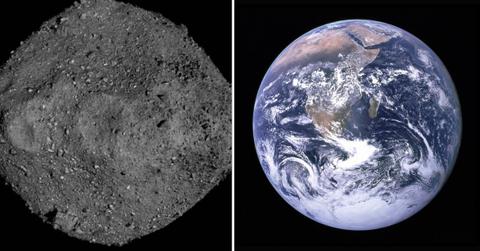End Days? Scientists Pinpoint Date Giant Asteroid May Hit Earth with Force of 22 Atomic Bombs

Don’t make any plans yet for Tuesday, Sept. 24, 2182. It could be a really, really bad day.
On that day, an asteroid could just possibly crash into Earth with the force of 22 atomic bombs.
Scientists already are tracking Bennu, the potentially disastrous asteroid. In fact, they hope to obtain samples from it in the next few days.
Bennu flies past Earth every six years. During one of its last close encounters, NASA sent a spacecraft to get pieces of it.
“It feels very much like the last few miles of a marathon, with a confluence of emotions like pride and joy coexisting with a determined focus to complete the race well,” Rich Burns with the Goddard Space Flight Center in Maryland said.
Britain’s Sunday Telegraph noted Bennu is as big as the Empire State Building. It’s about one-third of a mile wide.
That’s puny compared with the asteroid that some scientists blame for the death of dinosaurs. That one was believed to be about 20 times wider.
But if Bennu hits Earth directly, scientists say it could leave a crater six miles wide. Collateral damage could extend 600 miles in every direction from there.
- Asteroid That May Strike Earth in 2182 Contains Materials That Could Reveal Secrets About Human Origins: NASA
- Preparing for Impact: NASA's ‘Planetary Defense’ System Searching Space for Asteroids Capable of Causing 'Extinction Event'
- Cosmic Quest: Experts Urge Missions to Earth's Mini-Moons to Unlock Solar System Mysteries
So NASA is taking this seriously. A capsule containing samples from the 2020 NASA flight to Bennu should land in the Utah desert Sept. 24 for analysis.
That could lead to a plan to steer Bennu’s course.
But a big blow from Bennu is not a sure thing. Britain’s Daily Star reports the odds of a collision in September 2182 are one in 2,700.
That means you’re more than twice as likely to hit a “Cash 3” lottery drawing exactly.
The chances of Bennu hitting Earth by 2300 are better, at one in 1,750.
According to Earth.com, NASA did not notice Bennu until 1999. Astronomers first called it “1999 RQ36.”
The name Bennu came from a 9-year-old in North Carolina, based on a bird god in ancient Egypt.
Asteroids fly past Earth on a regular basis. The Jet Propulsion Laboratory keeps an online “Asteroid Watch” that tracks them.
On Sept. 18, for example, four were the size of an airplane, with the biggest estimated at 130 feet wide.
But none of the asteroids currently on NASA’s radar are as close to Earth as Bennu could come.
Become a Front Page Detective
Sign up to receive breaking
Front Page Detectives
news and exclusive investigations.
